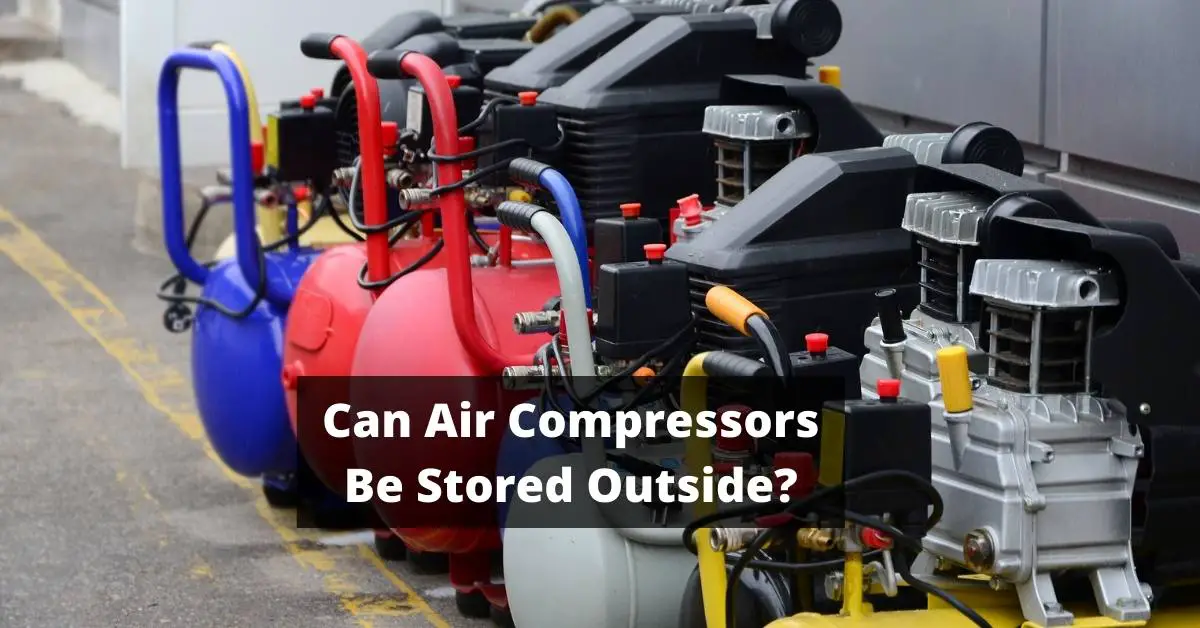As a DIY enthusiast, I’ve often found myself in situations where I need to move my air compressor from one place to another. And this brings up a question that many of us have asked at some point: can you lay an air compressor on its side?
I mean, it’s tempting to just lay it flat and slide it into the trunk of your car, right? But is it safe for the machine? Does it affect its performance in any way?
Well, as with most things related to machinery and tools, there isn’t a straightforward answer. It all depends on the type of air compressor you have and whether or not the manufacturer allows for laying it horizontally.
In this article, we’ll explore different types of air compressors, their oil systems, and what you should consider before deciding to lay your compressor on its side. So let’s dive in!
Types of Air Compressors
Hey, did you know there are different types of compressors for every job? It’s true! There are three main types of air compressors: reciprocating, rotary screw, and centrifugal. Each type has its own strengths and weaknesses, making them suitable for different applications.
Reciprocating compressors use pistons to compress air. They’re great for small jobs like powering pneumatic tools or inflating tires.
Rotary screw compressors use two interlocking screws to compress air, making them more efficient at producing a continuous stream of compressed air. These are commonly used in industrial settings because they can handle larger volumes of compressed air.
Finally, centrifugal compressors use high-speed rotating impellers to create compressed air. This type is typically used in large-scale industrial applications like power generation or chemical processing.
Knowing the right type of compressor for your job is important because using the wrong one can be inefficient and even dangerous. For example, using a small reciprocating compressor on a large industrial job could result in overheating or even explosion.
So next time you need an air compressor, consider which type will work best for your needs. And if you’re not sure which one to choose, don’t hesitate to ask an expert!
When it comes to choosing an air compressor, understanding the oil system is another important factor to consider. Different types of compressors require different amounts and types of lubrication oil to keep them running smoothly and efficiently. In the next section, we’ll take a closer look at how oil systems work in each type of compressor so you can make an informed decision when selecting the right one for your application.
Oil System
Before tilting the machine, it’s essential to understand how the oil system operates in an air compressor. The oil system is responsible for lubricating and cooling important components inside the compressor, such as bearings and pistons. Without proper lubrication, these parts can quickly wear out or become damaged, leading to costly repairs or even complete failure of the machine.
When you lay an air compressor on its side, you risk causing damage to the oil system. This is because the position of the compressor affects how oil flows through its internal components. If you lay it on its side with no precautions taken, there is a high chance that oil will pool in certain areas and not reach others at all. This can cause critical parts to overheat or break down due to lack of lubrication.
To avoid damaging your air compressor’s oil system when laying it on its side, be sure to follow manufacturer’s instructions carefully. These instructions may include specific steps for preparing your machine before tilting it or ways to maintain proper oil flow while it is tilted. By following these guidelines closely, you can ensure that your air compressor stays in good condition and continues working reliably for years to come.
Manufacturer’s Instructions
I can’t stress enough the importance of following manufacturer’s instructions, warning labels, and maintenance guidelines when it comes to any machinery. These guidelines are put in place for a reason – to ensure safety and optimal performance.
Ignoring these instructions can lead to serious harm or damage both to yourself and the equipment. So, always take the time to read through them carefully and follow them accordingly.
Importance of Following Manufacturer’s Instructions
Adhering to the manufacturer’s instructions is crucial in ensuring proper usage and maintenance of equipment. This includes following guidelines for storage, handling, operation, and maintenance. Failing to comply with these instructions can not only result in damage to the equipment but also pose safety hazards to you or those around you.
Ignoring the manufacturer’s guidelines can cause irreparable damage to your air compressor. For instance, if you lay an air compressor on its side when it’s not recommended by the manufacturer, it can cause oil leakage and even damage the motor. So always make sure that you read and understand all instructions before using any equipment.
In the next section, we’ll discuss how warning labels play a significant role in ensuring proper usage of tools and machinery.
Warning Labels
Oh great, just what we all need – more warning labels to ignore while using our tools and machinery. It seems like every time I purchase a new piece of equipment, there are at least five different labels on it warning me about potential hazards.
But as annoying as they may be, these warning labels are actually crucial in ensuring that we use our tools safely and correctly. For example, let’s say you’re considering laying your air compressor on its side for easier storage. Without the warning label advising against this action, you might not realize that doing so could cause oil to leak into the internal workings of the compressor and damage it beyond repair. By following these warnings and adhering to manufacturer guidelines, we can ensure that our equipment lasts longer and works more effectively. So next time you come across a warning label on your power tool or machine, don’t dismiss it – take it seriously for your own benefit!
As important as following warning labels is maintaining our equipment properly according to manufacturer guidelines. One simple maintenance tip for an air compressor is regularly changing its oil to prevent buildup and ensure proper lubrication. By taking care of our tools in this way, we can avoid costly repairs down the line and keep them running smoothly for years to come.
Maintenance Guidelines
Now that we’ve talked about the importance of warning labels, let’s move on to discussing maintenance guidelines for air compressors. As someone who’s used an air compressor before, I know how important it is to keep it in good working condition. Neglecting regular maintenance can lead to decreased performance and even safety hazards.
One of the most important things you can do for your air compressor is to check and change the oil regularly. This helps prolong the life of your machine and ensures that it operates smoothly. Additionally, cleaning or replacing filters is also crucial as they prevent dust and debris from entering your compressor’s motor.
By following these simple maintenance guidelines, you can ensure that your air compressor continues to perform at its best capacity.
As we move into discussing the pros and cons of laying an air compressor on its side, it’s important to remember that proper maintenance greatly affects its overall functionality.
Pros and Cons of Laying an Air Compressor on Its Side
As you tilt that powerful machine, the internal components shift and move, potentially causing damage or malfunction. This is especially true for oil-lubricated compressors, where the oil can leak out of the crankcase breather tube and into other parts of the compressor. When this happens, the oil may not be able to lubricate the moving parts properly, leading to overheating or even a complete breakdown.
However, there are some instances where laying an air compressor on its side may be necessary. For example, if you need to transport it in a car with limited space or store it in a tight area. In these cases, it’s important to make sure that all of the hoses and cords are disconnected from the compressor before tilting it over slowly. You should also allow any excess air pressure to escape before storing or transporting it.
Overall, while laying an air compressor on its side may seem like a convenient solution at times, it’s important to weigh up the potential risks against any benefits before doing so. If you do decide to tilt your compressor over for transportation or storage purposes, make sure that you take all necessary precautions to avoid damage or malfunctioning of your machine. As we move onto discussing transportation guidelines next, keep these tips in mind for safe handling of your air compressor.
Transportation Guidelines
Transporting an air compressor can be tricky, but following these guidelines will ensure its safe arrival at its destination.
First and foremost, always secure your air compressor in a stable position to prevent it from sliding around during transportation. You should also avoid laying the unit on its side or upside down during transport, as this can cause oil or other fluids to leak out of the machine and damage it.
If you must lay your air compressor on its side during transport, make sure to drain all fluids from the unit beforehand. This includes engine oil, coolant, and any other liquids that may be present in the compressor. Once drained, secure the unit with straps or bungee cords to ensure that it doesn’t shift or slide around while being moved.
By following these transportation guidelines for your air compressor, you can rest assured that it will arrive safely at its destination without sustaining any damage.
However, proper transportation is only one part of ensuring the longevity of your equipment. In the next section, we’ll cover storage guidelines that’ll help keep your air compressor running smoothly for years to come.
Storage Guidelines
When storing your machine, make sure to follow these helpful guidelines to keep it running smoothly for years to come. First and foremost, always store your air compressor in a dry area. Moisture can rust the internal components and damage the motor over time.
Additionally, ensure that the storage location is well-ventilated so that heat can escape from the machine. Another important factor to consider when storing your air compressor is its orientation. While it may be tempting to lay it on its side to save space, this could actually cause damage to the unit.
The oil inside may leak and mix with other fluids or clog up important valves and ports within the machine. Instead, store your air compressor upright in a secure position where it will not tip over. Lastly, remember to disconnect all hoses and attachments from the machine before storing it away.
This prevents any moisture or debris from accumulating inside of them and causing issues down the line. By following these simple storage guidelines, you can extend the lifespan of your air compressor and prevent costly repairs in the future.
As you move into maintenance and inspection of your air compressor, there are a few key things to keep in mind. Regularly check for leaks or damages around hoses, fittings, and belts as well as inspecting for any signs of wear on internal components such as pistons or bearings.
By catching potential issues early on through routine inspections, you can prevent larger problems down the line that may require more extensive repairs or replacements.
Maintenance and Inspection
As an air compressor owner, I know that regular maintenance and inspection are crucial to keep the machine running smoothly. To ensure that my compressor is always in top shape, I use an inspection checklist that covers all the essential parts and components.
In case of any issues or malfunctions, I also rely on troubleshooting tips to identify and fix the problem quickly.
Regular Maintenance
Maintaining your air compressor is as essential as breathing, so don’t neglect it! Regular maintenance can increase the longevity of your machine and prevent unexpected breakdowns.
One of the most important things to do is to regularly check and change the oil. Dirty oil can cause damage to the internal components of the compressor, but a simple oil change can keep everything running smoothly.
Another important aspect of regular maintenance is checking for leaks in hoses and connections. Leaks can cause a drop in pressure, which means that your compressor has to work harder and longer than necessary. By fixing any leaks you find, you’ll save on energy costs and reduce wear and tear on your machine.
Now that we’ve covered regular maintenance, let’s move onto an inspection checklist to ensure that your air compressor stays in top condition.
Inspection Checklist
Don’t overlook the importance of checking your air compressor regularly with this handy inspection checklist. This will help ensure that your equipment is in good working condition and prevent any potential hazards.
Start by inspecting the air filter, which should be cleaned or replaced as necessary. Check the oil level and condition, making sure to use the right type of oil specified in the manual. Inspect all hoses for wear and tear, and replace them if necessary.
Next, examine the pressure switch to make sure it’s functioning properly. The tank should also be checked for any signs of damage or rust buildup. Finally, test both safety valves and drain valves to ensure they’re working correctly.
By following this inspection checklist regularly, you can keep your air compressor in good working order for years to come.
To troubleshoot common issues with your air compressor, there are a few tips you can follow. Keep reading to learn how to identify and fix problems such as low pressure or unusual sounds coming from your equipment.
Troubleshooting Tips
Now that we’ve gone through the inspection checklist, let’s move on to some troubleshooting tips. There are a few common issues that may arise with an air compressor and knowing how to identify and fix them can save you time and money in the long run.
One issue that may occur is a lack of pressure or slow build-up of pressure. This could be due to a clogged filter or regulator, or a leak in the hose or fittings. Checking and cleaning these components can often solve this problem.
Another issue may be excessive noise coming from the compressor. This could be caused by loose parts or worn out bearings, which will need to be tightened or replaced respectively.
By being aware of these common issues and taking steps to address them, you can ensure your air compressor is functioning properly and efficiently for all your needs.
Conclusion
Overall, you can lay an air compressor on its side, but it can be a tricky decision to make. It’s important to identify the type of air compressor you have and whether it has an oil system that could be affected by being laid on its side. Always follow the manufacturer’s instructions and guidelines for proper handling and storage of your specific model.
While there may be potential benefits to laying an air compressor on its side, such as easier transportation or storage in tight spaces, there are also risks involved with potentially damaging the machine or affecting its performance. Ultimately, it’s up to the user to weigh these pros and cons and make a decision based on their individual needs.
In conclusion, properly maintaining and caring for your air compressor will ensure optimal performance and longevity. Whether transporting it or simply storing it away, take caution in handling your machine and refer to any manufacturer’s instructions provided. By doing so, you can avoid any unnecessary damage or complications down the line and continue using your trusty air compressor for years to come.


